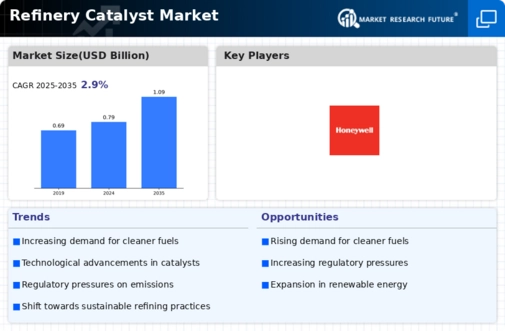Market Share
Refinery Catalyst Market Share Analysis
In the complex Refinery Catalyst market, players use market share positioning tactics to gain a competitive edge and a large share. Companies spend in R&D to improve refinery catalyst qualities to differentiate their products. This could include enhancing catalyst efficiency, selectivity, or other product-defining properties. This distinction attracts new consumers and builds brand loyalty among existing customers who respect these catalysts' revolutionary refining process optimization.
Petroleum derivative demand raises market demand and refinery catalyst market value. High-octane fuel boosts refinery markets. Urbanization, strict environmental restrictions, and high-quality refined goods expand the refinery market. Hydrocracking catalyst-produced ultra-low sulfur diesel boosts market growth. From diesel drilling to gasoline consumption, the petroleum fuel business is predicted to grow rapidly.
Market share positioning depends on pricing strategies. Some companies pursue cost leadership to become the market's cheapest producer. They can attract cost-conscious refineries and increase market share by offering competitive prices. Instead, premium pricing schemes target a specific market that values catalytic performance or views higher prices as a sign of quality. Companies seeking to dominate the Refinery Catalyst industry and satisfy varied refinery preferences must balance pricing and perceived value.
Distribution routes are key to market share. Companies create effective distribution networks to ensure refinery catalyst product availability. Strategic product placement and agreements with important distributors or retailers increase visibility and accessibility. Companies may reach more customers and streamline the buying process by integrating digital platforms and online channels.
Refinery Catalyst market share positioning requires brand building. Companies raise brand recognition, highlight unique catalyst formulations, and increase refinery client trust through focused marketing and promotions. Companies with a strong brand can charge more and have a higher market share since refineries are more likely to use catalysts from that brand for refining.
Effective Refinery Catalyst market share positioning strategies include strategic collaborations and partnerships. Company collaboration or strategic alliances might bring complementary resources, technologies, or markets. This synergy can boost market share and competitiveness. Collaborations, especially with research institutions or important suppliers, enable corporations to launch new and improved refinery catalysts, giving them a competitive edge in a sector that requires constant innovation.
Sustainability and environmental concerns are progressively influencing Refinery Catalyst market share. To fulfill the demand for cleaner and more efficient refinery processes, companies are creating eco-friendly catalyst solutions. This attracts environmentally concerned refineries and complies with worldwide trends and laws, improving market share.





Leave a Comment